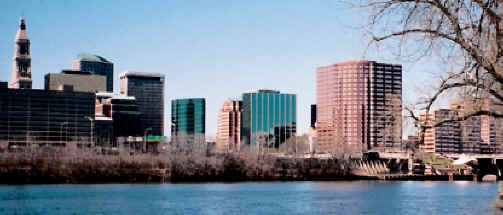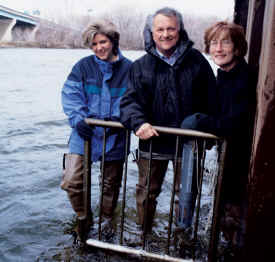
By Jim Smith
Signs of a warm and unseasonably dry New England winter have been in evidence for months all up and down the Connecticut River. Heavy with silt, it laps gently at area boat launches, drifting well below the algae-stained high water lines that remind us it is not always so demure.
Watching the Connecticut’s barely discernable current from some of the region’s riverside parks, it is hard to imagine that in 1936 and 1938 the river so violently flooded downtown Hartford that protective dikes were built. It may be difficult, in fact, to remember that scarcely a year ago, during spring runoff, the river swelled 12 feet and more up those boat ramps and, in a scant week, laid down an inch-thick layer of clay sediment.
But sooner or later, it will rain. And when that happens, you have to wonder what manner of crud, building up in the wells of municipal storm sewers through the long, balmy winter, will suddenly be flushed out.
Joe Marfuggi says the river is cleaner now than it has been in generations. An unabashed promoter, Marfuggi is the executive director of Riverfront Recapture, Inc., a private, nonprofit group created in 1981. For the past two decades, the group has spearheaded redevelopment of the Hartford riverfront, reuniting the city with the river from which it was separated when the floodwall was created 60 years ago, and creating a wide range of new recreational and commercial opportunities in the process.
Marfuggi’s undoubtedly correct. Still, people wonder. Just how clean is the river? Can you swim in it? Can you eat the fish? And how clean will it be when a big storm floods it with automotive residues off the streets, debris out of the sewers, and who knows what else?
Well, the answer is that nobody knows for sure. Remarkably, no one has ever tested the river to find out. But a team of scientists organized by Suzanne O’Connell, director of Trinity’s Center for Interdisciplinary Science, [pictured on far right] has set about doing just that. Over the next two years they will conduct a variety of tests, exploring just what sort of impact an urban center like Hartford has on the quality of New England’s grandest river.
That the team is conducting research never before undertaken is not the most distinguishing fact about the project, however. What’s more remarkable is that most of these scientists are only 17 years old or younger. They are students at the Greater Hartford Academy of Math and Science (GHAMAS), one of the regional high school programs housed at the Learning Corridor, the cornerstone of the $175 million Neighborhood Revitalization Initiative launched by Trinity and its Southside Institutions Neighborhood Alliance partners (Hartford Hospital, Connecticut Children’s Medical Center, the Institute for Living, and Connecticut Public Television and Radio) in 1996. Their research is part of a two-year study funded by the National Science Foundation. Its purpose is twofold.
 From
a strictly scientific standpoint, the grant will make it possible to assess
water quality and sedimentary processes in the river and its Hartford
tributaries for two years. On four bridges north and south of Hartford, the
team will install torpedo-like probes that make it possible to continuously
monitor the river’s oxygen, temperature, turbidity, conductance (a salinity
indicator), and acidity levels. Gauges will also make it possible to monitor
water-quality chemistry changes during storms. In addition, the project will
involve extensive river-bottom monitoring, including sampling of sediment,
photography, and multi-beam sonar scanning.
From
a strictly scientific standpoint, the grant will make it possible to assess
water quality and sedimentary processes in the river and its Hartford
tributaries for two years. On four bridges north and south of Hartford, the
team will install torpedo-like probes that make it possible to continuously
monitor the river’s oxygen, temperature, turbidity, conductance (a salinity
indicator), and acidity levels. Gauges will also make it possible to monitor
water-quality chemistry changes during storms. In addition, the project will
involve extensive river-bottom monitoring, including sampling of sediment,
photography, and multi-beam sonar scanning.
When the project is complete in 2004, its leaders hope to have a much clearer understanding of the condition of this 11,000-year-old river that was born at the end of the last ice age, and of Hartford’s impact on its health.
But the project has another purpose, equally important—to creatively introduce urban high school students to earth science as a problem-solving tool with real meaning for their lives. The hope is that if the effort is successful, participating students will develop, as the project proposal put it, “an appreciation for and understanding of earth science as an important urban need and therefore choose careers related to earth science.”
“A major goal of this project is to provide opportunities in math and science areas underrepresented by minorities,” explains Jeffrey L. Osborn, director of GHAMAS. [In photo above with Janet Morrison, visiting assistant professor of Chemistry (left), and Suzanne O'Connell]. It is also a major goal of the academy, and Osborn underscores its significance by citing an astounding statistic. In the past 30 years, 20,000 doctorate degrees in the geosciences have been awarded in America. Care to guess how many of those went to minority students? Fewer than 300.
Osborn worked closely with the Center for
Interdisciplinary Science in the development of the National Science
Foundation grant application. “The project is built around activities that
relate to students’ environments and their world,” Osborn says. “We’re
trying to get the students involved in the notion that they can have an impact
on their world and their neighborhood and how that world relates to the
Connecticut River watershed.”
We all live downstream (or upstream) from somebody
About 25 ninth and tenth grade GHAMAS students will participate in the program each year, starting this summer. They are in for a hands-on learning experience.
 Working closely with Professor Janet Morrison, the
project’s chemist, they will receive not only classroom instruction, but
also opportunities to use sophisticated analytical equipment such as a
spectrophotometer and two kinds of chromatographs (liquid and gas) already
available at GHAMAS.
Working closely with Professor Janet Morrison, the
project’s chemist, they will receive not only classroom instruction, but
also opportunities to use sophisticated analytical equipment such as a
spectrophotometer and two kinds of chromatographs (liquid and gas) already
available at GHAMAS.
They will also benefit from the involvement of the Environmental Research Institute (ERI) at the University of Connecticut, an independent analytical chemistry laboratory with experience testing for mercury levels in the Connecticut River. ERI staff members will set up remote sampling stations on the four Hartford-area bridges. And over the next two years, they will conduct water-quality tests following 20 different storms. Their findings will provide an accurate baseline against which the students can test their own findings.
What will they find? Of course, no one knows, but Christopher Perkins, associate director of ERI, expects to find copper, metal from automobile brake linings, and petroleum products, among other things. “There are different ways to measure pollutants,” he notes, “and there are always uncertainties associated with analytical chemistry.” Those uncertainties provide one of the project’s learning opportunities.
Another is being provided thanks to Andy Robinson, a Trinity engineering student from Champagne, Illinois. For his senior engineering project, Robinson is writing a user-friendly software program that will translate sonar data, making it possible for students in the GHAMAS project to actually see the bottom of the river and observe any changes that take place following storms.
“This project truly is interdisciplinary,” says O’Connell, who notes that in addition to many different scientific disciplines, the participating scientists will also use boats built by Hartford-area youngsters who participated in a Riverfront Recapture summer boat-building program. “That is one of its central goals.”
In the final analysis, the program’s success will be measured by its effectiveness in answering several questions. Can an innovative program like this fuel the imaginations of urban youngsters and encourage more of them to embark upon careers in the geosciences? What will it tell us about the river? And can the project’s findings change behaviors that negatively affect the river?
O’Connell hopes that one of the consequences of the project will be heightened public awareness of everyone’s responsibility for the river. “I hope we can get more people to really understand the idea of a watershed,” she says. “No matter where you live in the Connecticut River Valley, the things you do, or don’t do, affect the river.”